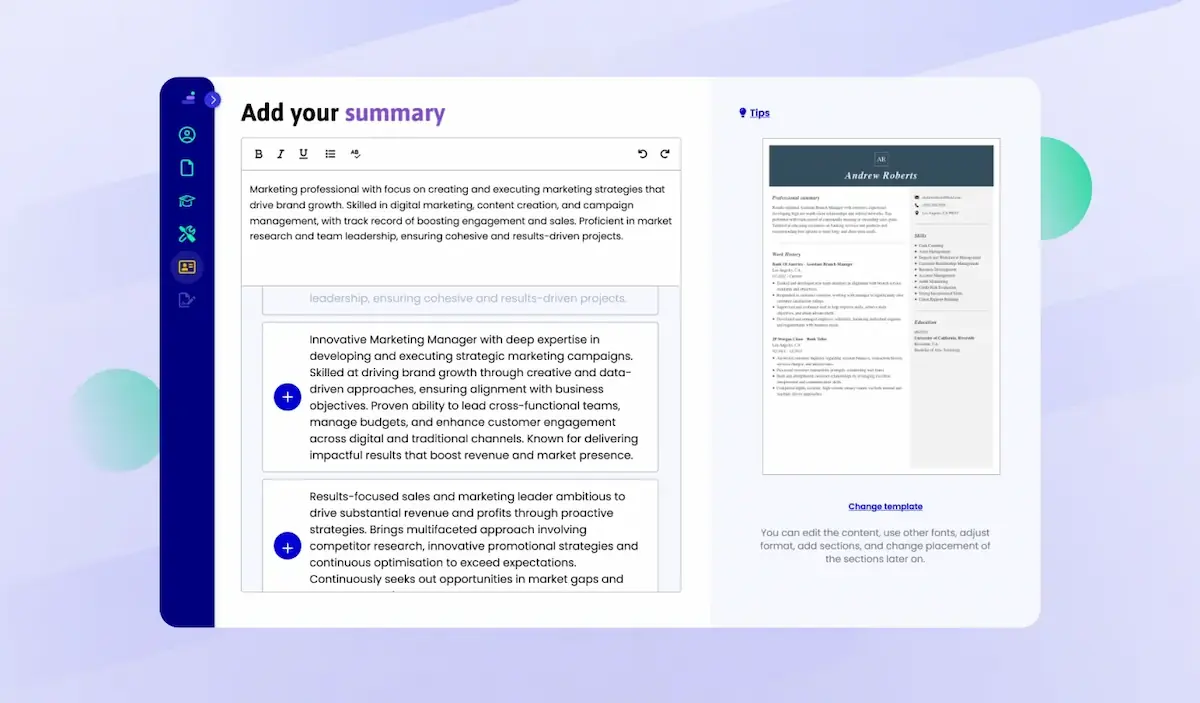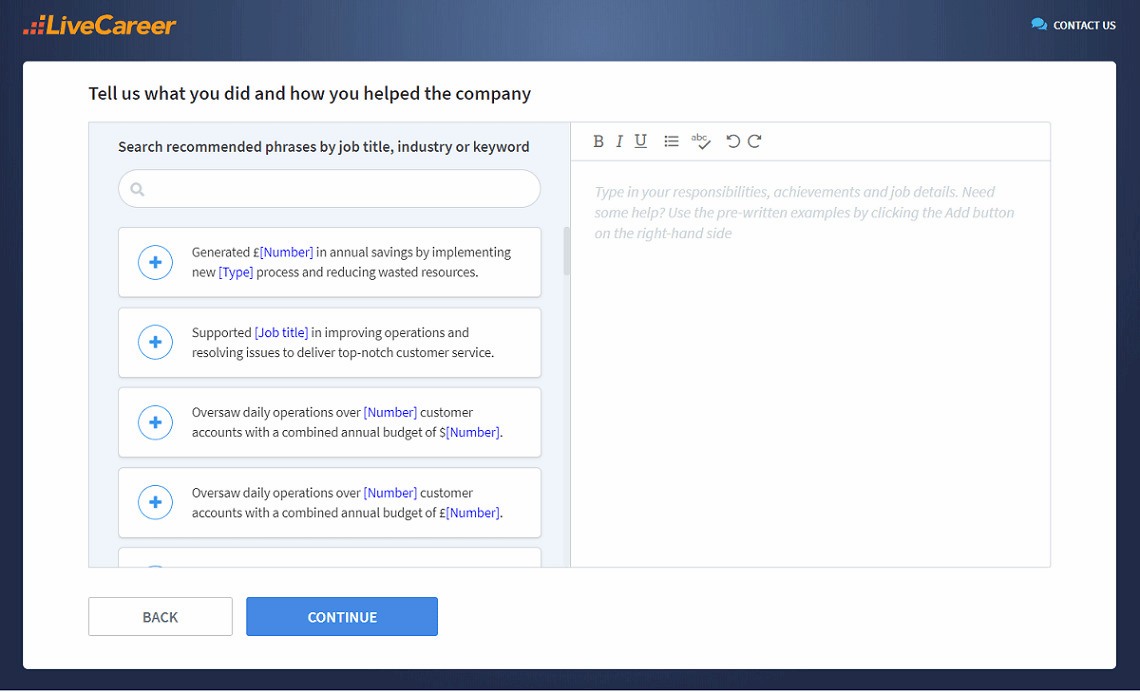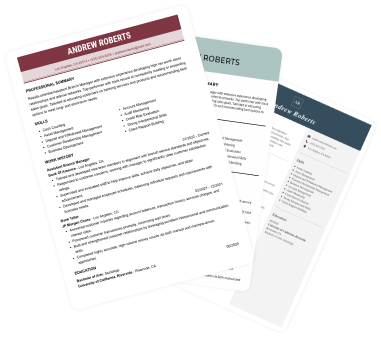Create a professional CV now!
 NO
NO YES
YESLast updated on 13 November, 2025

Whether you’re entering the UK job market, considering a career shift, or looking to future-proof your skills, you need to understand which industries are in demand to stay on top of things.
In this article, I’ll provide a comprehensive overview of the current UK labour market based on ONS labour market statistics and CBI labour market update. I’ll break down employment trends, vacancy levels, wage growth, and the sectors with the strongest (and weakest) demand. You’ll also learn what this means for your job search, which industries are hiring, and how to align your skills with what employers need.
Create an effective CV in minutes. Choose a professional CV template and fill in every section of your CV in a flash using ready-made content and expert tips.
Create a professional CV now!
 NO
NO YES
YESWe created the sample on the right using our builder. See other good CV examples like this one.
Seeking more career advice? Check these guides, too:
To understand the job market and its fluctuations, let’s examine key labour market indicators such as employment, unemployment, and inactivity rates. They show the number of people working, the number of people unemployed, and the number of people not currently participating in the workforce.

Here’s how it looks in the United Kingdom (March to May 2025, unless stated), based on Office for National Statistics data:
This means that just over three-quarters of working-age people in the UK are currently employed. It’s a slight but positive increase compared to the beginning of the year and the same time last year, suggesting a modest recovery in job creation.
This is the highest level since 2021. It indicates that more people are actively seeking employment but haven’t yet found it. The rising rate shows that job security is weakening and competition for roles is growing.
This number refers to individuals who are neither working nor currently seeking employment. It might be due to inability to work, illness, studying, or early retirement. The slight drop suggests that more people are re-entering the job market.
This number includes employees, self-employed people, and others in paid work. While the overall number has risen slightly over the past year, payroll data shows that 135,000 fewer people are on company payrolls compared to May 2024. This suggests that growth may involve less secure or temporary positions.
This is the number of people claiming unemployment benefits. It has increased compared to the same time last year, showing more financial pressure on job seekers and a possible rise in long-term unemployment.
Although employment has grown slightly, the overall picture indicates a weakening job market, characterised by rising unemployment and a decline in the number of people on payrolls.
Vacancy data tells us a lot about which industries are hiring, and which ones aren’t. A decreasing number of job openings might suggest a lowered demand, economic uncertainty, or hiring freezes. Here, I use the data from the Confederation of British Industry to assess the pulse of employer recruitment activity across the UK:
This is the total number of job openings across the UK during this period. It’s down by 56,000 compared to the previous quarter and 143,000 fewer than the same time last year. This is the lowest level of vacancies seen since early 2021, during the pandemic recovery phase.
Each quarter for ninestraight years, the number of job openings has fallen, showing a long-running slowdown in recruitment across the economy.
Most industries are hiring fewer people than before, suggesting the trend is widespread rather than limited to a few specific areas.
Companies continue to slow recruitment or freeze hiring due to high costs and uncertainty. Some employers are urging the government to step in, requesting new support, such as a Growth and Skills Levy to fund non-apprenticeship training, and tax-free Employee Assistance Programmes to help workers with their wellbeing and mental health.
With fewer job openings and more cautious employer behaviour, there’s greater competition for jobs. Even in growing industries, it may take longer to find a suitable opportunity. To stand out, focus on in-demand skills and tailor your CV carefully for each application.
A strong CV summary will convince the recruiter you’re the perfect candidate. Save time and choose a ready-made personal statement written by career experts and adjust it to your needs in the LiveCareer CV builder.

Let’s have a closer look at the sectors showing the strongest demand, driven mostly by digital transformation, sustainability, and healthcare needs. If you’re unsure where to focus your job search or which skills to develop, these high-growth areas are a smart place to start.
The digital transformation is driving strong demand for skilled professionals in areas like AI development, cybersecurity, software engineering, and data science. Companies across all industries seek tech talent to upkeep their systems and boost efficiency. At the same time, CBI highlights skills shortages in IT. Soft skills in tech are also in high demand.
Demand trend: High and consistent
The transition to a low-carbon economy is creating numerous opportunities in renewable energy, energy efficiency, sustainable transportation, and environmental management. Employers are hiring for positions that support net-zero goals, from solar panel engineers to sustainability consultants.
Demand trend: Growing steadily
The ONS notes that the healthcare sector remains a top industry for job vacancies, with significant demand for nurses, mental health professionals, and care workers. These professions are particularly high in demand due to an ageing population and NHS constraints. If you're applying for one of these roles, see our mental health nurse CV example for guidance.
Demand trend: Strong expansion
According to ONS, there is a particular demand for teachers and trainers in STEM subjects (science, technology, engineering, and maths), as well as in digital skills. These educators are key to closing the UK’s growing skills gap and preparing the workforce of the future. Find out how to create a strong teacher CV.
Demand trend: Notable and increasing
Infrastructure and housing projects are supporting demand in skilled trades, project management, and civil engineering. However, recruitment levels can vary depending on government funding, regional development, and economic conditions.
Demand trend: Mixed, with areas of growth
The ONS report states that the hospitality and retail sectors are still in recovery mode following the pandemic. Some regions and employers are hiring again—especially in tourism and high-demand service roles—but performance remains uneven, and hiring can quickly react to shifts in the broader economy. A compelling hospitality CV might help you break into the sector and stand out in a competitive job market.
Demand trend: Volatile and region-dependent
These industries offer better job security and growth potential over the next few years. Focus your job search in these areas, or train skills relevant to them, to increase your chances of finding a job and moving forward with your career.
While some industries grow, other sectors slow down due to automation, globalisation, and changing consumer behaviour and habits. If you currently work in one of these areas, it may be worth researching new career paths or developing skills that are in higher demand elsewhere.
Here are the sectors projected to decline:
The ONS reports that typical manufacturing roles are being slowly replaced by automation and robotics, especially in repetitive and manual tasks. However, there’s still potential in advanced manufacturing areas such as precision engineering and high-tech production.
Key challenge: Lower demand for low-skilled jobs, with growing emphasis on tech-focused roles in modern manufacturing.
Roles such as data entry professionals, call handling, and basic admin tasks are being automated or outsourced to reduce costs. Many businesses are also decreasing their support staff as they adopt more digital systems.
Key challenge: Fewer openings and rising redundancy risk in routine admin roles.
According to the CBI, there has been a long-term shift towards e-commerce, which is expected to continue to reduce the need for traditional retail roles. Currently, many retail businesses are closing their physical locations, which limits new job opportunities.
Key challenge: A long-term decline in physical retail roles, with a shift toward e-commerce and digital customer service.
This shows that once stable roles may no longer provide the same level of security. If you’re in one of these industries, it’s a good time to consider reskilling and retraining, or transitioning into sectors with better long-term prospects, such as tech, healthcare, or green energy.
It’s not just about how many jobs are available—the way people work in the UK is also changing. Things that undergo changes include work patterns, different skill needs, pay trends, and more. Here’s what’s happening right now, and how it could affect your next move.
Remote and hybrid roles remain popular, particularly in the tech, finance, and professional services sectors. Workers value flexibility, and many employers still offer it. However, with the decreasing number of job vacancies, candidates may have less power to negotiate flexible arrangements, especially outside high-demand industries.
What this means: You may still find flexible roles, but be prepared for stronger competition and fewer remote-first openings, particularly in non-digital sectors.
Despite fewer vacancies overall, many employers report serious gaps in skills. The most in-demand areas include:
To stay competitive, workers are increasingly expected to upskill or reskill, whether through short courses, on-the-job training, or formal qualifications.
What this means: Developing new skills, especially in digital or green sectors, can greatly improve your job prospects and long-term career stability.
While wages are still rising, the rate of growth has moderated in recent months, reflecting a softer labour market. That said, many workers are finally seeing real-term pay increases, thanks to falling inflation.
Key pay trends (latest figures):
What this means: While pay is improving overall, gains are more minor than earlier in the year. Strong pay growth in the public sector may make it a more attractive option for some job seekers.
Reviewing these trends may help you make more informed decisions about your next role, identify the skills to invest in, and where to look for greater job security or flexibility. Being informed puts you in a stronger position, even in a more competitive job market.
Fewer people in the UK are currently out of work and not actively seeking employment, but the rate is still higher than it was before the pandemic. The main reasons are long-term health issues, early retirement, and caring duties. While some have returned to work, health problems remain the most significant barrier, making it harder for employers to find the talent they need.
What this means: Even as unemployment rises, many roles remain unfilled because employers can’t find people with the right skills—or enough people able to work. This adds pressure to both employers and job seekers.
The UK job market is undergoing a significant transformation due to technological advancements, demographic shifts, and economic uncertainty. Some sectors are growing, others are shrinking, and workers face both challenges and opportunities depending on their circumstances.
Here’s a summary of the latest labour market data (March to May 2025 unless stated):
Overall, the labour market is cooling, with fewer vacancies and higher competition, but also opportunities for those in the right sectors or willing to acquire new skills.
On a final note, here are essential action points:
Need more career advice? Read these guides:
You don’t have to be a CV writing expert. In the LiveCareer CV builder you’ll find ready-made content for every industry and position, which you can then add with a single click.

Thanks for reading this article about the current UK labour market. Wishing you confidence, clarity, and success in your next career move.
Our editorial team has reviewed this article for compliance with LiveCareer’s editorial guidelines. It’s to ensure that our expert advice and recommendations are consistent across all our career guides and align with current CV and cover letter writing standards and trends. We’re trusted by over 10 million job seekers, supporting them on their way to finding their dream job. Each article is preceded by research and scrutiny to ensure our content responds to current market trends and demand.
Category: Career Advice
Crafting a job-winning CV is all about showcasing your unique skills and experiences. Start with a strong personal statement that highlights your career goals and achievements.
Try Our CV Builder Now